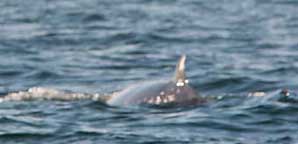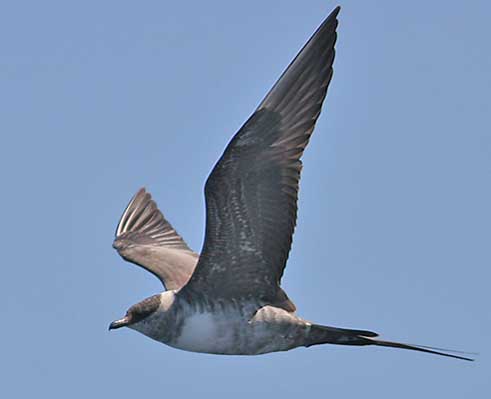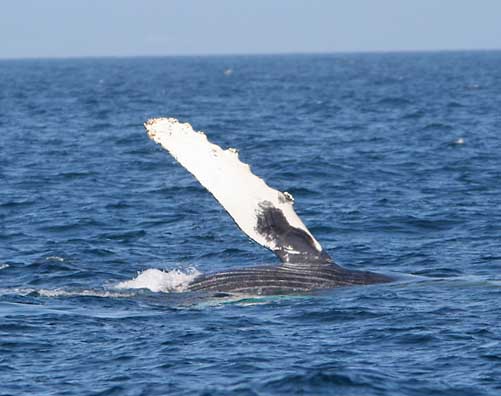| |
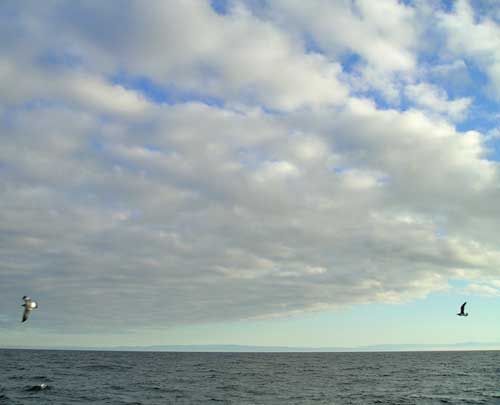 Monterey
Seabirds offered a 12-hour offshore trip to the "albacore grounds" on
15 Sep 2007. As the scheduled leaders for Roger Wolfe and skipper
Richard Ternullo, Dan Singer & I duly turned up at the dock at 5:30
a.m. There was a lovely sunrise (above) as we headed offshore, bearing
southwest from Pt. Pinos. All morning the sky was spectacular (right).
We would reach 45 nmi offshore before having to head home. Monterey
Seabirds offered a 12-hour offshore trip to the "albacore grounds" on
15 Sep 2007. As the scheduled leaders for Roger Wolfe and skipper
Richard Ternullo, Dan Singer & I duly turned up at the dock at 5:30
a.m. There was a lovely sunrise (above) as we headed offshore, bearing
southwest from Pt. Pinos. All morning the sky was spectacular (right).
We would reach 45 nmi offshore before having to head home.
While
birds were the focus, this would prove to be the best Monterey Bay
whale-watching trip I've ever been on, at least for rare cetaceans. The
first — a Sei Whale ~ 3.5 nmi offshore — slipped away
with without photos, behaving elusively as is typical of this scarce
and rarely seen rorqual. |
|
|
| We had just been talking about the baby Cuvier's Beaked (Goose-beaked) Whale Ziphius cavirostris
that was found dead on Asilomar beach just days before (right; Alan
Baldridge is the expert observing), when the a 20-foot beaked whale
broke the surface some 6 nmi offshore (above). The size, brownish tone,
and white flank spotting helped identify this as a very rare at-sea
encounter with Goose-beaked Whale! We were quite lucky to approach so
close on fairly calm seas (below) before it sounded for good. Of those
on the trip, only Richard and I had previously seen Ziphius in Monterey County. We had already seen two of the county's rarest cetaceans before getting very far offshore. |
|
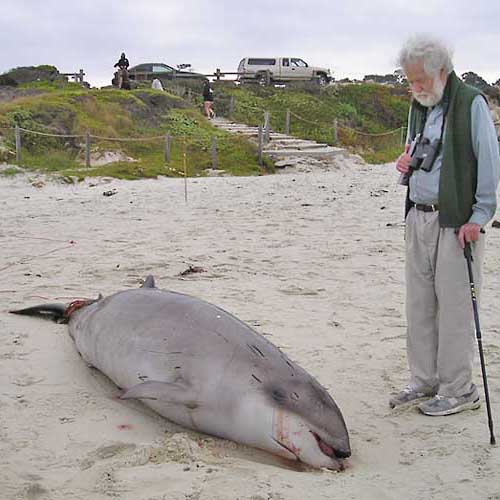 |
|
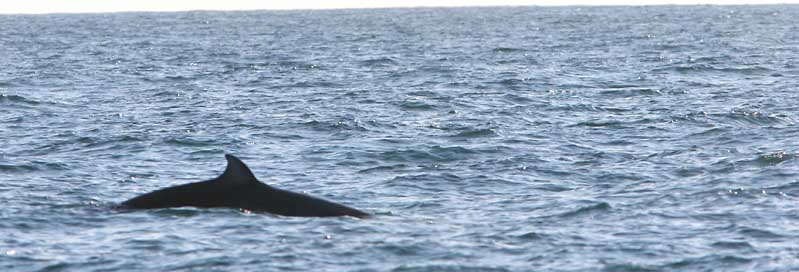
| Birds
were not forgotten. While there are long, slow stretches in reaching
the warm waters of the "albacore grounds," we did have scattered flocks
of Sabine's Gull (below left) and a fine show of
jaegers. Among the ~65 individuals were 4 South Polar Skua, a dozen
Pomarine, a half-dozen Parasitic, and 33 Long-tailed Jaegers (one Long-tailed Jaeger
is shown, below right). Most of the Long-tails were well offshore —
beyond 40 nmi offshore — where the warm water had lots of jumping tuna,
moon jellies, a swordfish, and one Scripps's Murrelet. |
|
|
|
| When
we did reach the 'tongue' of warm Pacific gyre water offshore, it was
pretty obvious. The color became very blue and the visibility
underneath us was incredible. When a pod of Short-beaked Common Dolphin
found us (above) and began to bow-ride (right), it was like watching
them in the tropics (below, next two shots). Since the split of Common
Dolphin into two species late last century, Long-beaked has been the
more usual species to be encountered annually in late summer on
Monterey Bay. Short-beaked can occur in numbers but typically only in
the warmest waters. I've seen it many times in the tropics but never
have been able to photograph it in Monterey County — until this trip. |
|
|
|
|
| Later,
en route home about 13 nmi off Pt. Pinos, distant round, puffy blows
(right) revealed a pond of another rarely seen local cetacean: Baird's Beaked Whale Berardius bairdii.
They dove before we reached them, so views were distant (below). Roger
Wolfe tells me, however, that incredible views were had on the next
day's pelagic trip. |
|
|
|
| The
combination of 3 very rare cetaceans — Sei and two beaked whales — plus
the patchy & erratic Short-beaked Common Dolphin, turned this day
into a prize–winning pelagic trip. We also had more regular species,
including Pacific White-sided Dolphin & Dall's Porpoise in large
groups. But as they often are, the stars of the show were a pair of
very active Humpback Whale (right & below).
Richard spotted them fin-waving, tail-slapping, and breaching miles
away, and they seemed to intensify their efforts as we got close. In
all, a spectacular day on the waters of Monterey Bay. |
|
|
|
|
|
|
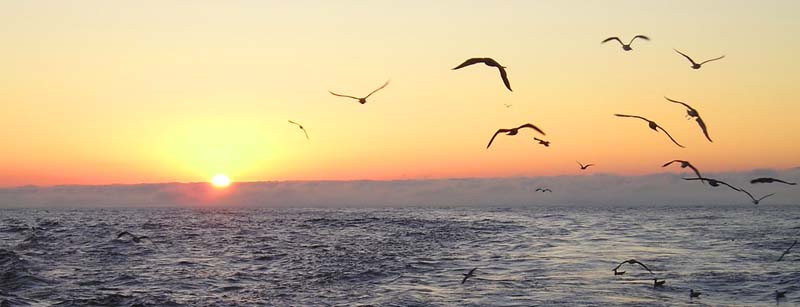



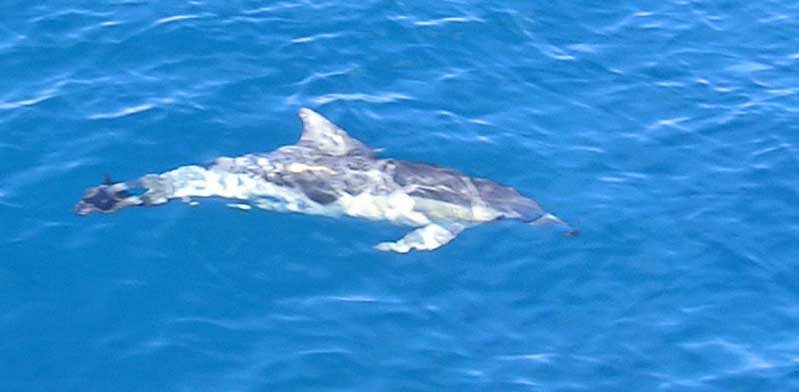
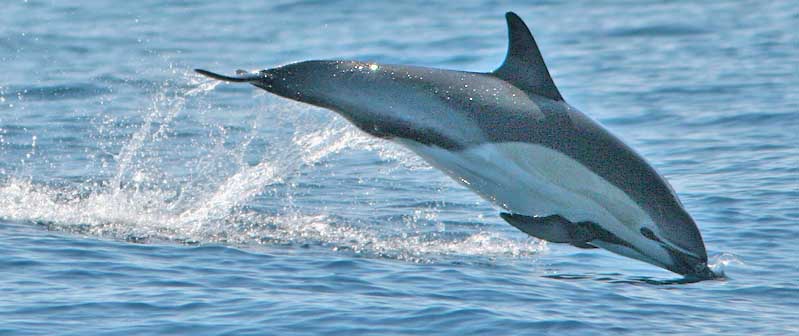

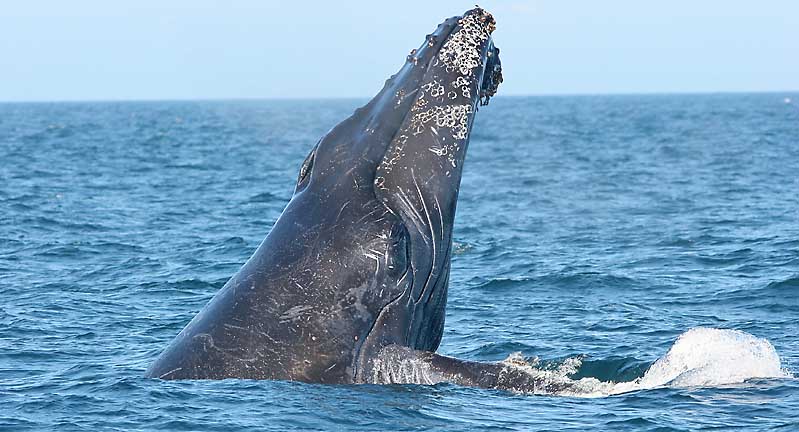

 Monterey
Seabirds offered a 12-hour offshore trip to the "albacore grounds" on
15 Sep 2007. As the scheduled leaders for Roger Wolfe and skipper
Richard Ternullo, Dan Singer & I duly turned up at the dock at 5:30
a.m. There was a lovely sunrise (above) as we headed offshore, bearing
southwest from Pt. Pinos. All morning the sky was spectacular (right).
We would reach 45 nmi offshore before having to head home.
Monterey
Seabirds offered a 12-hour offshore trip to the "albacore grounds" on
15 Sep 2007. As the scheduled leaders for Roger Wolfe and skipper
Richard Ternullo, Dan Singer & I duly turned up at the dock at 5:30
a.m. There was a lovely sunrise (above) as we headed offshore, bearing
southwest from Pt. Pinos. All morning the sky was spectacular (right).
We would reach 45 nmi offshore before having to head home.